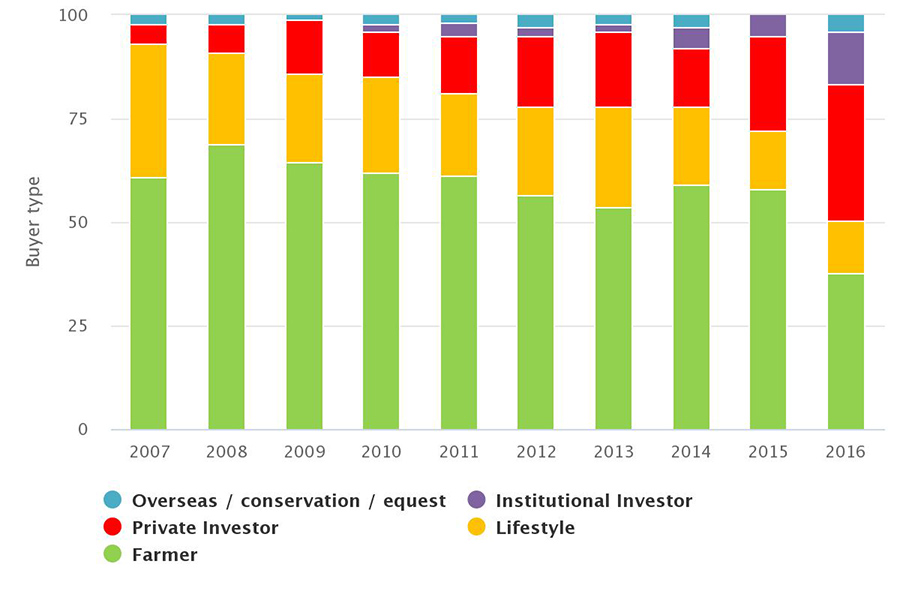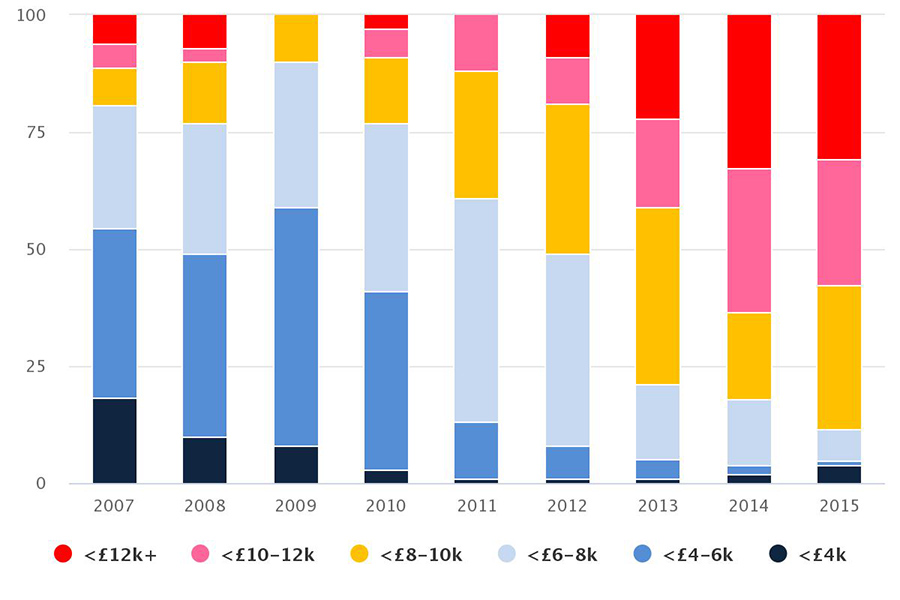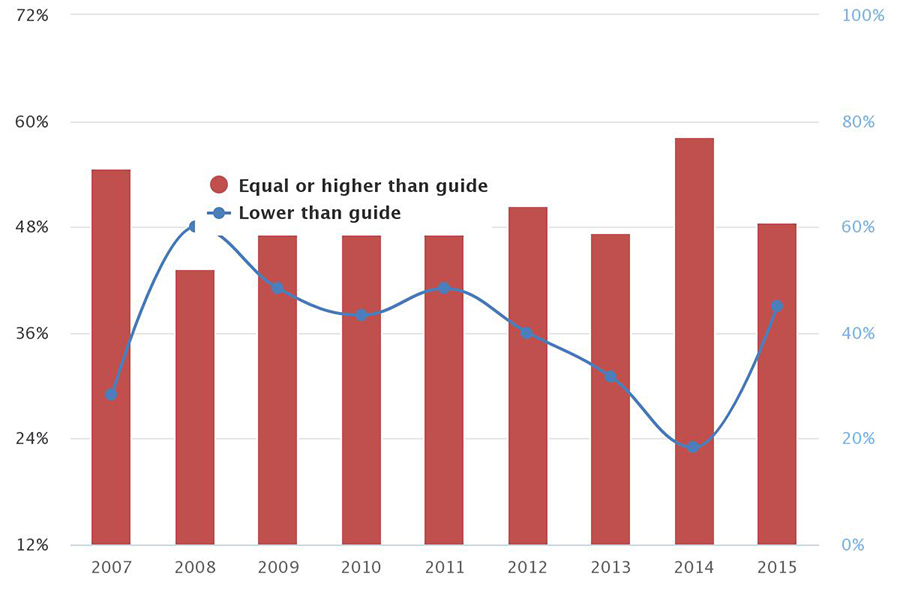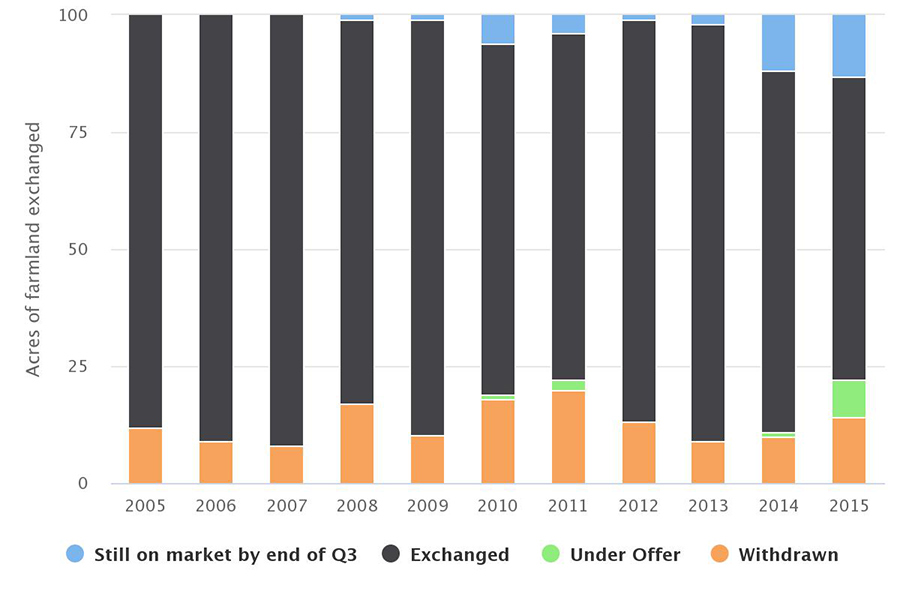Five charts that explain England’s farmland market
New research demonstrates the extent to which the English farmland market is changing.
Strutt & Parker’s latest farmland review reveals a marked shift in buyer type, with the number of private and institutional investors continuing to rise while farmer purchasers dwindle.
Fewer acres been marketed in 2016 compared to last year, and evidence shows a significant reduction in completed transactions on land launched for sale in 2015.
See also: Number of unsold farms rise as pressure on profits bite
Prices have taken a hit too, with nearly 40% of sales last year failing to meet their guide price. We take a closer look at the agent’s research and what it shows.
All data in the charts below is supplied by Strutt & Parker.
The changing buyer profile
Buyer type

Just 38% of farmland sold so far in 2016 was to farmers while the rise of private and institutional investor continues apace, accounting for 46% of transactions this year.
The decline has been evident since 2008 when farmer purchasers bought nearly 70% of land and private investors just 7%.
Falling farm profitability and commodity prices have been the main drivers, leaving farmers with less cash to spend, while those looking to roll-over capital relief have become more active.
Private investors are tending to buy blocks under 500 acres, while institutional investors want as many acres as possible.
More expensive farmland continues to dominate
Sales by price band

There has been a huge swing in the prices paid for land in the past five years.
In 2015, 61% of farmland sold for more than £10,000/acre. Go back to 2010 and that figure was just 25%.
Just 6% of last year’s sales saw less than £6,000/acre paid – that figure was 40% as recently as 2009.
Jason Beedell, partner and head of research at Strutt & Parker, said: “It’s purely down to price inflation. There used to be farms at £4,000/acre to £6,000 but there are hardly any there anymore.”
Guide prices not being met
Agreed farmland

The proportion of sales not achieving their guide price spiked sharply last year, leaping from 23% to 39%.
Arable land took the brunt of the hit, with 37% sold below the guide.
Jason Beedell added: “It’s a combination of buyers becoming a lot more choosy and some land being over-valued. Everyone has become a bit more savvy and rather than paying the guide price or over they are challenging prices a lot more.”
Slower sales overall
Acres farmland exchanged

About 13% of publicly and privately marketed farmland across all agents was still for sale by the end of Q3 in 2015 – more than double the figure five years before and a 333% increase on the 10-year average of 3%.
Jason Beedell said: “People are waiting for the right farm in the right place. It’s such a thin market – the 112 farms lunched so far this year sounds a lot but if you’re looking for a large arable farm, perhaps with good transport links, you could be waiting a long time. Buyers are also a lot more cautious and aware of value.”
Marketed acres down
Amount of famland marketed by acre |
|||||||
| 2011 | 2012 | 2013 | 2014 | 2015 | H12015 | H12016 | |
| East Midlands | 23,600 | 10,100 | 11,500 | 6,500 | 18,600 | 9,900 | 5,300 |
| East of England | 21,000 | 16,400 | 13,400 | 15,900 | 21,800 | 12,400 | 13,200 |
| North East | 4,500 | 16,200 | 9,100 | 4,600 | 4,500 | 4,500 | 2,300 |
| North West | 5,900 | 4,500 | 2,600 | 3,600 | 55,600 | 5,000 | 1,100 |
| South East | 12,200 | 14,200 | 12,800 | 11,900 | 22,300 | 15,000 | 4,800 |
| South West | 15,900 | 14,200 | 17,500 | 14,400 | 13,600 | 5,800 | 4,900 |
| West Midlands | 10,800 | 6,500 | 9,600 | 12,000 | 5,700 | 2,000 | 2,800 |
| Yorkshire/Humber | 7,000 | 5,000 | 6,600 | 5,500 | 4,800 | 1,900 | 7,500 |
| England | 100,900 | 87,000 | 83,000 | 74,300 | 146,900 | 56,500 | 41,900 |
Overall, 41,900 acres were launched for sale to the end of June 2016 – down 26% on the same period last year.
Land launches in South-East England were down 68% while three large estates being sold in Yorkshire and the Humber have made it the only region to report a surge in available acres.
The price of arable land is now 9% lower than a year ago at £9,800/acre while pasture prices rose slightly but are still 5% down on last year with an average of £7,500/acre.
